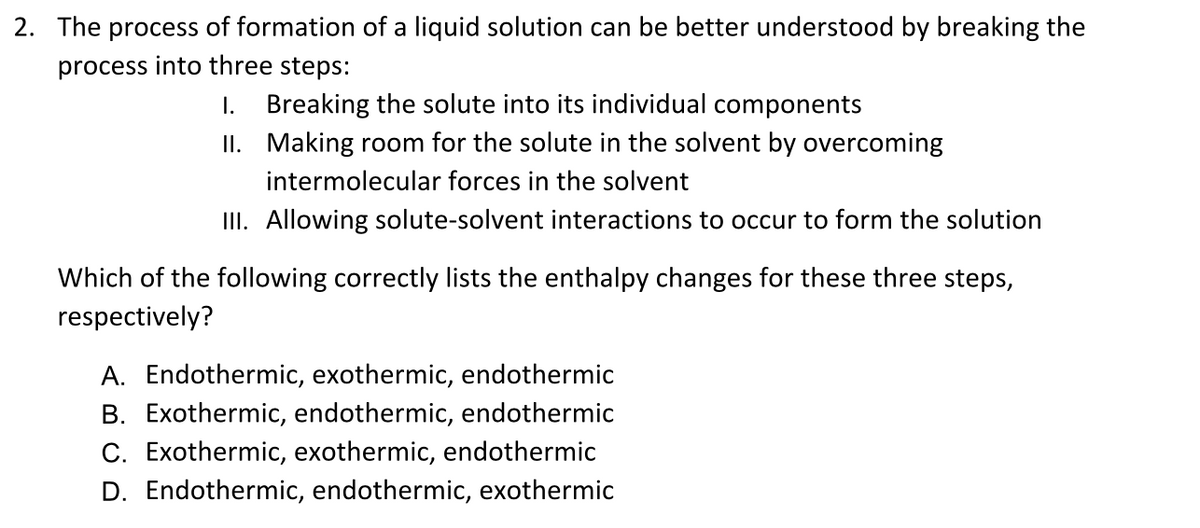2. The process of formation of a liquid solution can be better understood by breaking the process into three steps: Breaking the solute into its individual components II. Making room for the solute in the solvent by overcoming I. intermolecular forces in the solvent III. Allowing solute-solvent interactions to occur to form the solution Which of the following correctly lists the enthalpy changes for these three steps, respectively? A. Endothermic, exothermic, endothermic B. Exothermic, endothermic, endothermic C. Exothermic, exothermic, endothermic D. Endothermic, endothermic, exothermic
2. The process of formation of a liquid solution can be better understood by breaking the process into three steps: Breaking the solute into its individual components II. Making room for the solute in the solvent by overcoming I. intermolecular forces in the solvent III. Allowing solute-solvent interactions to occur to form the solution Which of the following correctly lists the enthalpy changes for these three steps, respectively? A. Endothermic, exothermic, endothermic B. Exothermic, endothermic, endothermic C. Exothermic, exothermic, endothermic D. Endothermic, endothermic, exothermic
Chemistry: Principles and Practice
3rd Edition
ISBN:9780534420123
Author:Daniel L. Reger, Scott R. Goode, David W. Ball, Edward Mercer
Publisher:Daniel L. Reger, Scott R. Goode, David W. Ball, Edward Mercer
Chapter12: Solutions
Section: Chapter Questions
Problem 12.4QE
Related questions
Question
8, Q2

Transcribed Image Text:2. The process of formation of a liquid solution can be better understood by breaking the
process into three steps:
1. Breaking the solute into its individual components
II. Making room for the solute in the solvent by overcoming
intermolecular forces in the solvent
III. Allowing solute-solvent interactions to occur to form the solution
Which of the following correctly lists the enthalpy changes for these three steps,
respectively?
A. Endothermic, exothermic, endothermic
B. Exothermic, endothermic, endothermic
C. Exothermic, exothermic, endothermic
D. Endothermic, endothermic, exothermic
Expert Solution
This question has been solved!
Explore an expertly crafted, step-by-step solution for a thorough understanding of key concepts.
This is a popular solution!
Trending now
This is a popular solution!
Step by step
Solved in 2 steps

Knowledge Booster
Learn more about
Need a deep-dive on the concept behind this application? Look no further. Learn more about this topic, chemistry and related others by exploring similar questions and additional content below.Recommended textbooks for you

Chemistry: Principles and Practice
Chemistry
ISBN:
9780534420123
Author:
Daniel L. Reger, Scott R. Goode, David W. Ball, Edward Mercer
Publisher:
Cengage Learning

Principles of Modern Chemistry
Chemistry
ISBN:
9781305079113
Author:
David W. Oxtoby, H. Pat Gillis, Laurie J. Butler
Publisher:
Cengage Learning

World of Chemistry, 3rd edition
Chemistry
ISBN:
9781133109655
Author:
Steven S. Zumdahl, Susan L. Zumdahl, Donald J. DeCoste
Publisher:
Brooks / Cole / Cengage Learning

Chemistry: Principles and Practice
Chemistry
ISBN:
9780534420123
Author:
Daniel L. Reger, Scott R. Goode, David W. Ball, Edward Mercer
Publisher:
Cengage Learning

Principles of Modern Chemistry
Chemistry
ISBN:
9781305079113
Author:
David W. Oxtoby, H. Pat Gillis, Laurie J. Butler
Publisher:
Cengage Learning

World of Chemistry, 3rd edition
Chemistry
ISBN:
9781133109655
Author:
Steven S. Zumdahl, Susan L. Zumdahl, Donald J. DeCoste
Publisher:
Brooks / Cole / Cengage Learning

Chemistry: An Atoms First Approach
Chemistry
ISBN:
9781305079243
Author:
Steven S. Zumdahl, Susan A. Zumdahl
Publisher:
Cengage Learning

Chemistry
Chemistry
ISBN:
9781305957404
Author:
Steven S. Zumdahl, Susan A. Zumdahl, Donald J. DeCoste
Publisher:
Cengage Learning
